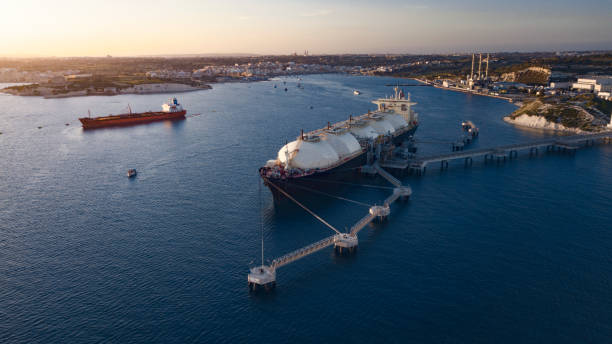The China National Offshore Oil Corp (CNOOC), the country’s largest liquefied natural gas (LNG) importer, this week became the first company to make a group LNG purchase on the Shanghai Petroleum and Natural Gas Exchange (SHPGX).
The state-run oil and gas behemoth procured a 120,000-tonne cargo scheduled to arrive at one of its terminals in April, as well as other approved hubs in Shenzhen and Guangdong, a SHPGX statement revealed. Buyers will have until the end of September to collect their purchases.
The new purchasing option allows a group leader, in this case CNOOC, to receive, manage and divide the imported cargo, while helping to allocate it among smaller players, including local gas distribution companies.
Read more: FTSE Russell indexes poised to axe more China firms
These smaller players would otherwise have had difficulty procuring imported LNG. The new SHPGX procurement change also adds more gas supply options than before and this will reverberate across China’s natural gas sector.
The development fits perfectly into Beijing’s gas and LNG market liberalisation playbook. The country, the world’s largest gas consumer – and its second largest LNG importer set to soon eclipse Japan for the top slot – has seen its gas sector come a long way in just a few years.
From a strict reliance on access to LNG import terminals by China’s three state-run oil majors (CNOOC, Sinopec, CNPC), independents are now gaining new ground, while the country is also close to having one of the most developed LNG value chains in the world – second only to Japan.
Japan, for its part, particularly given its size and dwindling population of now under 130 million people, has been punching above its weight in energy markets for decades. It has been a major importer and a key investor in international oil and gas projects, and boasts a mature LNG value chain.
3RD LARGEST ECONOMY
Japan, which was relegated to the world’s third largest economy, slipping behind China just a few years ago, was the fourth-largest crude oil importer in the world in 2019, and is still the world’s top LNG importer. The country also ranked as the world’s third-largest coal importer behind China and India in 2019.
As of mid-2020, Japan operated some 37 LNG import terminals with a total natural gas send-out capacity of approximately 10 trillion cubic feet per year (Tcf/y), the world’s largest by far, according to the US Energy Information Administration (EIA).
Japan also has the largest LNG storage tank capacity in the world, about 643 million cubic feet (MMcf) as of early 2020, which serves as a buffer during seasons of higher LNG demand.
Yet, Japan’s regasification capacity exceeded its natural gas demand at an average terminal utilisation rate of 36% in 2019. As such, Japan’s LNG sector has matured to the point of redundancy, exacerbated even more as its LNG demand growth will become flat going forward.
NUCLEAR POWER
Some of this is due to Japan’s decreasing population, less energy consumption and hence LNG demand, in addition to a ramp-up in more nuclear power that had been sidelined for years after the 2012 Fukushima nuclear disaster that eventually saw the shutdown of the country’s some 50 nuclear power plants at the time.
As of this month, around one-third of Japan’s nuclear capacity was back online, with more likely to follow even given ongoing and often fierce legal push-backs.
Renewables (wind, solar and now hydrogen) will also capture increased shares of Japan’s future energy mix, also creating headwinds for its LNG sector.
China, for its part, is at the other end of the LNG spectrum. As of late 2019, China had 21 LNG import terminals with a combined capacity of 3.5 Tcf, according to the EIA’s most recent analysis of the country’s energy sector.
China is also quickly building various terminals along its entire coastline, with another 1.9 Tcf under construction and slated to come online by 2023, the EIA added.
However, an even more robust LNG build-out than the EIA’s forecast could ensue. This comes just a few years after Beijing finally opened up its LNG sector by not only granting third-party access to the Big Three’s LNG import terminals, but by liberalising domestic gas pricing, and even promoting LNG trading hubs.
EXTRA BUILD-OUTS
New market policies are also incentivising a plethora of private and smaller state-run companies to build their own LNG import terminals, of varying sizes, adding to the 1.9 Tcf extra build-out forecast by the EIA.
Chen Zhu, managing director of Beijing-based consultancy SIA Energy, said that with greater access to gas distribution networks, these smaller terminals could account for 40% of the country’s LNG receiving capacity by 2030, versus 15% now.
China’s gas appetite will also remain unquenched as the country of some 1.4 billion people recovers a year on from the onset of the Covid-19 pandemic. The World Bank said two weeks ago that it will be the only G20 country to post positive economic growth for the year, while projecting that in 2021 its economy will grow at a 7.9% clip.
The Paris-based International Energy Agency (IEA) predicts that China will remain the key driver of global gas demand growth post-crisis, adding more than 130 bcm/y of incremental gas demand between 2019 and 2025.
























